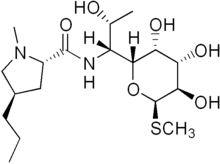Lincosamides

Lincosamides are a class of antibiotics which include lincomycin, clindamycin, and pirlimycin.
Mechanism of action
Lincosamides prevent bacteria replicating by interfering with the synthesis of proteins. They bind to the 23s portion of the 50S subunit of bacterial ribosomes and cause premature dissociation of the peptidyl-tRNA from the ribosome.[1] Lincosamides do not interfere with protein synthesis in human cells (or those of other eukaryotes) because human ribosomes are structurally different from those of bacteria.
History and uses
The first lincosamide to be discovered was lincomycin, isolated from Streptomyces lincolnensis in a soil sample from Lincoln, Nebraska (hence the bacterial name).
The use of lincomycin as an antibiotic has been largely superseded by clindamycin which exhibits improved antibacterial activity. Clindamycin also exhibits some activity against parasitic protozoa and has been used to treat toxoplasmosis and malaria.
Lincosamides are normally used to treat Staphylococcus and Streptococcus but have also proved to be useful in treating Bacteroides fragilis and some other anaerobes. They are used in the treatment of toxic shock syndrome and thought to directly block the M protein production that leads to the severe inflammatory response.
Lincosamide antibiotics are one of the classes of antibiotics most associated with pseudomembranous colitis caused by Clostridium difficile.[2]
Resistance
Target bacteria may alter the drug's binding site (similar to resistance found in macrolides and streptogramins). The resistance mechanism is methylation of the 23s binding site. If this occurs then the bacteria are resistant to both the macrolides and the lincosamides. Also, enzymatic inactivation of clindamycin has been described (rare).
Formulation
The lincosamides, as the hydrochloride salts, are bitter to taste, so for oral formulation they are given as the palmitate esters, or formulated in capsules. Clindamycin is given intravenously as clindamycin phosphate, which is then converted into active clindamycin within the body.
Pharmacodynamics
These are bacteriostatic drugs and antagonists of macrolides and streptogramins.
Further reading
- Van Bambeke F. Mechanisms of action. In Armstrong D, Cohen J. Infectious diseases. Mosby, London, 1999, pp7/1.1-7/1.14
